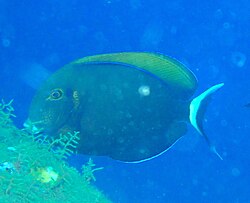Biology:Acanthurus bariene
| Acanthurus bariene | |
|---|---|

| |
| Scientific classification | |
| Domain: | Eukaryota |
| Kingdom: | Animalia |
| Phylum: | Chordata |
| Class: | Actinopterygii |
| Order: | Acanthuriformes |
| Family: | Acanthuridae |
| Genus: | Acanthurus |
| Species: | A. bariene
|
| Binomial name | |
| Acanthurus bariene Lesson, 1831
| |
| Synonyms | |
| |
Acanthurus bariene, the bariene surgeonfish, black-spot surgeonfish, or eye-spot surgeonfish, is a species of marine ray-finned fish belonging to the family Acanthuridae, the surgeonfishes, unicornfishes and tangs. This species is found in the Indo-Pacific.
Taxonomy
Acanthurus bariene was first formally described in 1835 by the French zoologist René Primevère Lesson with its type locality given as Offack Bay on Waigeo in Indonesia.[3] The genus Acanthurus is one of two genera in the tribe Acanthurini which is one of three tribes in the subfamily Acanthurinae which is one of two subfamilies in the family Acanthuridae.[4]
Etymology
Acanthurus bariene has a specific name, bariene, which is derived from barîène, the local name for surgeonfishes at the type locality.[5]
Description
Acanthurus bariene has 9 spines and between 26 and 28 soft rays supporting the dorsal fin while the anal fin is supported by 3 spines and 25 or 26 soft rays.[2] It has a deep body with its body being half its standard length and a convex dorsal profile to the head. The overall colour of the body is brown, gradually changing to yellowish-brown on the breast and belly, this is broken up by a large number of irregular horizontal greyish-blue lines. There is a black spot, similar in size to the eye, at upper end of gill opening, with a yellow bar running from the rear of the spot to under the pectoral fin. The dorsal fin is yellow with a thin blue line along its margin and base while the lobes of the lunate caudal fin are yellow.[6] This species has a maximum published total length of 50 cm (20 in).[2]
Distribution and habitat
Acanthurus bariene is found in the Indian and Pacific Oceans from the Seychelles east to the Solomon Islands, south to Australia and north to the Ryukyu Islands.[1] It is typically found in the outer slopes of coral reefs at depths greater than 30 m (98 ft).[6]
References
- ↑ 1.0 1.1 Choat, J.H.; Abesamis, R.; Clements, K.D. et al. (2012). "Acanthurus bariene". IUCN Red List of Threatened Species 2012: e.T177978A1509145. doi:10.2305/IUCN.UK.2012.RLTS.T177978A1509145.en. https://www.iucnredlist.org/species/177978/1509145. Retrieved 6 September 2023.
- ↑ 2.0 2.1 2.2 Froese, Rainer and Pauly, Daniel, eds. (2023). "Acanthurus bariene" in FishBase. June 2023 version.
- ↑ Eschmeyer, William N.; Fricke, Ron; van der Laan, Richard, eds. "Species in the genus Acanthurus". California Academy of Sciences. http://researcharchive.calacademy.org/research/ichthyology/catalog/fishcatget.asp?tbl=species&genus=Acanthurus.
- ↑ J. S. Nelson; T. C. Grande; M. V. H. Wilson (2016). Fishes of the World (5th ed.). Wiley. pp. 497-502. ISBN 978-1-118-34233-6.
- ↑ Christopher Scharpf; Kenneth J. Lazara, eds (12 January 2021). "Order ACANTHURIFORMES (part 2): Families EPHIPPIDAE, LEIOGNATHIDAE, SCATOPHAGIDAE, ANTIGONIIDAE, SIGANIDAE, CAPROIDAE, LUVARIDAE, ZANCLIDAE and ACANTHURIDAE". The ETYFish Project Fish Name Etymology Database. Christopher Scharpf and Kenneth J. Lazara. https://etyfish.org/acanthuriformes2/.
- ↑ 6.0 6.1 Bray, D.J. (2022). "Acanthurus bariene". Fishes of Australia. Museums Victoria. https://fishesofaustralia.net.au/home/species/1021.
External links
- Photos of Acanthurus bariene on Sealife Collection
Wikidata ☰ Q1963645 entry
 |


